Address: 302 Jackson St., Brooklyn, IA
Featuring a 20 X 38 foot flag flown on an 80 foot pole, surrounded by flags from every state and the Armed Services Flags.
Address: 302 Jackson St., Brooklyn, IA
Featuring a 20 X 38 foot flag flown on an 80 foot pole, surrounded by flags from every state and the Armed Services Flags.
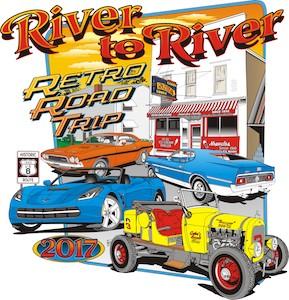
The dates have been set for the 2017 River to River Retro Road Trip. Our 7th annual cruise across Iowa will be held September 15-17, 2017. For more info Click here
U.S. Highway 6 (US 6) is an east–west U.S. Highway which runs 319 miles (513 km) across the U.S. state of Iowa. The route is signed in places as the Grand Army of the Republic Highway. Like all state highways in Iowa, it is maintained by the Iowa Department of Transportation. The route begins at the Missouri River crossing at Council Bluffs. From there, it travels east through Oakland and Atlantic. North of Atlantic, the highway overlaps Interstate 80 (I-80) until De Soto. Between De Soto and Adel, the highway overlaps US 169 before splitting off to the east towards Des Moines. Through the Des Moines area, the highway runs about one mile (1.6 km) north or south of the I-35 / I-80 corridor.

The River to River:Iowa’s Forgotten Highway 6 DVD has arrived! Fourth Wall Films is shipping several hundred “River to River” DVDs (along with orders for other titles). Place your order TODAY and YOUR copy will be one of them!

The RIVER TO RIVER: IOWA’S FORGOTTEN HIGHWAY 6 premiere date is set! A few weeks later than originally hoped for but mark your calendars for Thursday evening, September 17th, 2015 to celebrate with us at the Putnam Giant Screen! You’ll know you are at the right place by the classic cars in the lot! Pre-order your DVD at http://docublogger.typepad.com/highway6/reserve-your-copy-of-the-river-to-river-documentary-dvd.html and save $$! We hope to see you there!
Click the link below to see a sneak peek at the movie trailer!
“River to River: Iowa’s Forgotten Highway 6” Trailer (v.1.2) from Kelly Rundle on Vimeo.
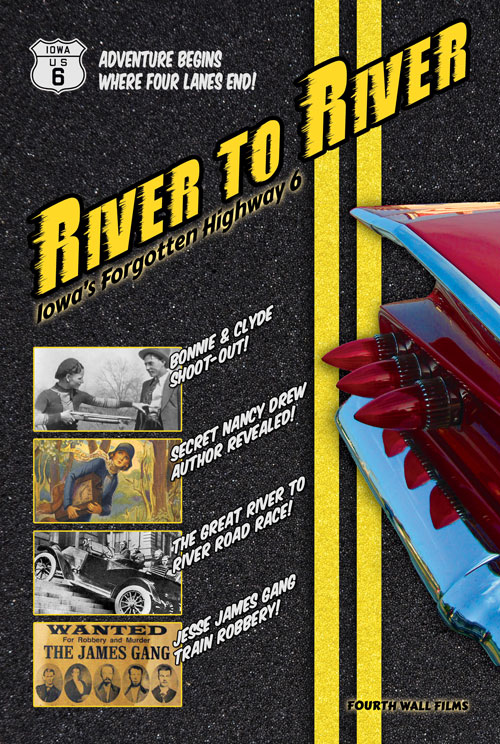

By Tom Emery on January 25, 2015 12:00 am
Among the nation’s highways, U.S. Route 66 has become synonymous with Americana, its story captured in songs and television shows as well as marketing campaigns to attract international tourists.
U.S. 6, which rolls through Des Moines, never has enjoyed such recognition. But supporters say that Route 6 has “half the digits and twice the kicks” of its cult-status counterpart.
“There’s a lot of significance in Route 6,” remarked Curt Roseman of Moline, Ill., a retired geography professor from the University of Southern California. “A lot of people just don’t know about it, like they do with 66 or other famous highways.”
Route 6, which stretches some 3,205 miles from Massachusetts to California, is the longest contiguous highway in the nation, running unbroken through five state capitals and 14 states. In 1937, the highway became transcontinental when it was extended to Long Beach, Calif. The route was the nation’s longest highway until 1965, when the section from Long Beach northward to Bishop was decommissioned.
During that time, Route 6 ran for 3,662 miles, as compared to the 2,448 miles of Route 66 from Chicago to Santa Monica, Calif. U.S. 20, now the longest highway in the nation, measures 3,345 miles.
The roots of Route 6 date to 1925, when its first numbered segment ran from Provincetown, Mass., near the farthest point on Cape Cod, to Brewster, N.Y. Six years later, it was extended to Greeley, Colo., which took it through northern Indiana.
Today, Route 6 enters Northwest Indiana through central LaPorte County, runs westward through Westville, Portage and Hobart, and turns north through Lake Station to join Interstates 80 and 94 toward Illinois.
Much of the path of Route 6 was the Sauk Indian Trail of the late 1700s, sometimes called the Great East-West Trail. A modern forerunner to U.S. 6 was Ind. 6, for which signs were erected between the Illinois line and Westville in 1926. Signs for U.S. 6 were then installed in the summer of 1932, when the road was paved.
Roseman became interested in Route 6 based on his own experiences. “When I was at USC, my office was a half-block off the old route of 6,” he said. “I grew up in Moline, which also has Route 6. When we’d come back home from California, we’d take Route 6, sometimes twice a year.”
As a result, Roseman, his wife Libby, and Kevin Patrick of Indiana, Pa. launched a research project about Route 6 to collect historical and contemporary data. Roseman says his interest reflects his career pursuit.
“In geography, you want to take in many things,” he said. “You want to study not only the highway itself, but the roadside businesses, the regions the highway travels through, the cities that grew up along it, the people that live with it. You want a wide array of information.”
Their efforts resulted in a website that interprets the history and locations of Route 6. Formerly hosted by Augustana College, the site is now located within www.heritagedocumentaries.org, a Quad Cities-area group in which Roseman is heavily involved.
The website includes historical information along with a tour map, bibliography and fun facts about Route 6 that help fill the public-relations void that the highway seems to suffer from.
“U.S. Route 30 is the old Lincoln Highway, and people still refer to it as such,” said Roseman. “Route 20 is the longest, while U.S. Route 40 was built along the National Road, which has great historical meaning. And, of course, there’s Route 66. I think Route 6 just doesn’t get that type of hype.”
While many of those roads, particularly Route 66, have been studied in books or television programs, Route 6 does have a place in literature that reflects its lack of respect. In Jack Kerouac’s novel “On the Road,” a main character thinks about hitchhiking along Route 6 to Nevada, but is discouraged by a driver who tells him “there’s no traffic passes through 6.”
Similarly, historian and novelist George Stewart considered Route 6 for a study of the transcontinental U.S. in the late 1940s before settling on Route 40. He reasoned that “Route 6 runs uncertainly from nowhere to nowhere, scarcely to be followed from one end to the other, except by some devoted eccentric.”
Certainly, the towns along Route 6 would disagree, and offer plenty of other stories to tell. In 1953, the route was designated the “Grand Army of the Republic Highway” to honor the influential Civil War veterans’ organization.
In Iowa, major parts of the legendary “River to River Road” that was constructed in a single day in 1910 later became Route 6. In the 1920s, the future path of Route 6 in Iowa was marked by utility poles painted white, giving birth to the nickname “White Pole Road.”
“It’s not as famous as Route 66, by any measure, but Route 6 is certainly important,” concluded Roseman. “It used to be the longest highway in the country, and it runs through many major cities and towns. I think it deserves to be understood and appreciated.”
(Source: <a href=”http://www.nwitimes.com/news/opinion/forum/route-has-plenty-of-stories-to-tell/article_a7a26012-7b67-5eb0-b830-eaa7dc7004b8.html” target=”_blank”>http://www.nwitimes.com/news/opinion/forum/route-has-plenty…</a>)



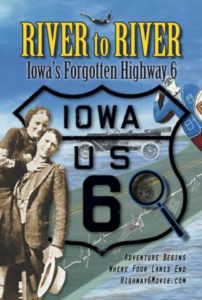
The Putnam Giant Screen will host the June premiere of RIVER TO RIVER: IOWA’S FORGOTTEN HIGHWAY 6 and kick off a screening tour of the film in numerous towns along Historic Route 6 from Davenport to Council Bluffs, Iowa. Visit www.Highway6Movie.com often to get the latest updates!
RESERVE Your “River to River” DVD!
For a limited time you can now pre-order and reserve your copy of the upcoming River to River: Iowa’s Forgotten Highway 6 DVD at a REDUCED PRICE!
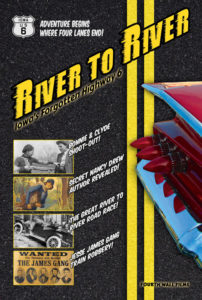
$20 per DVD price includes FREE shipping!*
The suggested retail price of the DVD after this offer expires will be $24.99 plus $3.00 shipping.
Thank you for supporting this important film project with your purchase!
To purchase by PayPal click here.
You can also send a check or money order for $20 payable to:
Fourth Wall Films
P.O. Box 702
Moline, IL 61265
The anticipated release date of the DVD is June 2015.
DVDs will begin shipping immediately following the premiere event on the Putnam Giant Screen in Davenport, Iowa.
DES MOINES, Iowa – If you’re a classic car lover, there’s still time to take part in a road trip across Iowa on Highway 6.
The drive isn’t until October, but the Iowa U.S. Route 6 Tourist Association is trying to get the word out now. The goal of the three-day “River to River Retro Road Trip” is to raise awareness of the history of Route 6, and to support small mom-and-pop shops along the way.
“You can either come out and enjoy the parade of classic cars as they drive by, or you can join and have a blast and enjoy these little mom-and-pop shops along the way, all of which are unique and special in their own way,” said David Darby, executive director of the association.
You can get more information and register for the road trip here.
[ Source: WHOTV ]
By Kirby Kaufman
Just remember: Under Iowa law, scooters and mopeds are motorcycles, too.
About 20 people gathered Friday in Council Bluffs in the 100 block of Broadway to begin a ride across Iowa along U.S. Highway 6 as part of the River to River Motorcycle Cruise.
Rodger Freel and his wife, Tami, both of Des Moines, chose to ride a scooter because they had recently switched from motorcycles.
“We’ve done this all over on scooters,” Tami Freel said of travelling. “It’s kind of like seeing a dog out of the window with his ears and tongue flopping. You get the thrill of fresh air.”
The couple had previously participated in a classic car ride across Iowa. However, Rodger Freel said, they prefer to travel by bike.
“This is a thrill for me,” he said. “I’d rather be on two wheels than four wheels.”
Motorcyclists will continue across the state through Newton, Adel, Des Moines, Altoona and Colfax before arriving at their final destination, Davenport.
Council Bluffs Mayor Matt Walsh said the event was an opportunity to bring more attention to downtown Council Bluffs.
“Anytime we get people in town from out of town, it’s good for Council Bluffs,” Walsh said.
Barry Cleaveland, director of research and development for Omaha-based SilverStone Group and an organizer of the event, said the event also brought recognition to stops along historic U.S. Highway 6.
The Iowa Division of the Route 6 Tourist Association, which sponsors the event, plans to install historic U.S. Highway 6 signs across the state in an effort to recognize the road and promote local businesses.
“We want to bring attention to all the communities on Highway 6,” said David Darby, the organization’s executive director. “We like to encourage people to stop at local mom and pop establishments.”
U.S. Highway 6 stretches 3,205 miles from Provincetown, Mass., to Bishop, Calif. It formerly stretched 3,652 miles from Long Beach, Calif., to Provincetown, making it the nation’s longest highway, before portions of its California route were decommissioned.
Riders traveled through Pottawattamie County and made stops at the freedom rock located in Oakland and White Pole Road, which was designed in the early 1900s to follow along the Chicago, Rock Island and Pacific Railroad line from Des Moines to Council Bluffs.
Mike Brink rode three hours from Dover, Kan., to Council Bluffs to participate in the ride across Iowa. He also chose to ride a scooter instead of a traditional motorcycle.
“There’s no cattle to feed and no work to worry about,” he said. “You can relax and watch the world go by.”
[ Source: The Dail Nonpareil ]
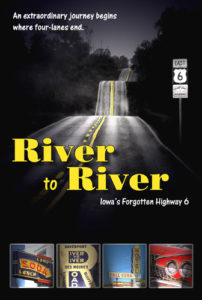
What do Bonnie & Clyde, Jesse James, Nancy Drew, John Wayne, Jack Kerouac, Gary Cooper, a meteorite strike, and the inventor of barbed wire have in common? U.S. Route 6 in Iowa takes two-lane motorists from Davenport on the Mississippi to Council Bluffs on the Missouri. Built in one day by 10,000 farmers and businesses across the state, Iowa’s Route 6 is part of the second longest transcontinental highway in America. “River to River: Iowa’s Forgotten Highway 6” guides viewers on a nostalgic classic car journey through yesterday’s soda shops, filling stations, general stores, drive-ins, and roadside attractions. Experience the sights and sounds, the people and the places that the four-lanes have forgotten…before they are gone forever. From award-winning filmmakers Kelly & Tammy Rundle and inspired by the Highway 6 research and photography of David W. Darby.